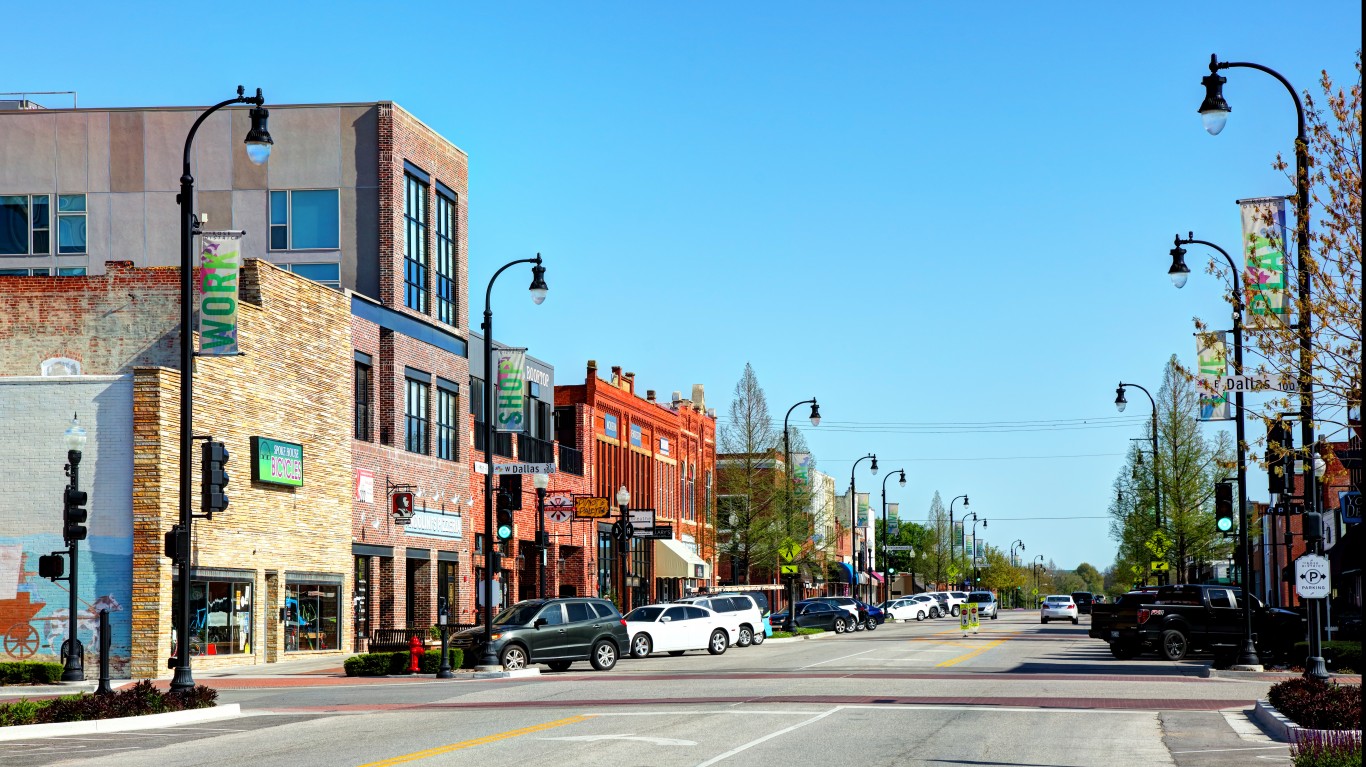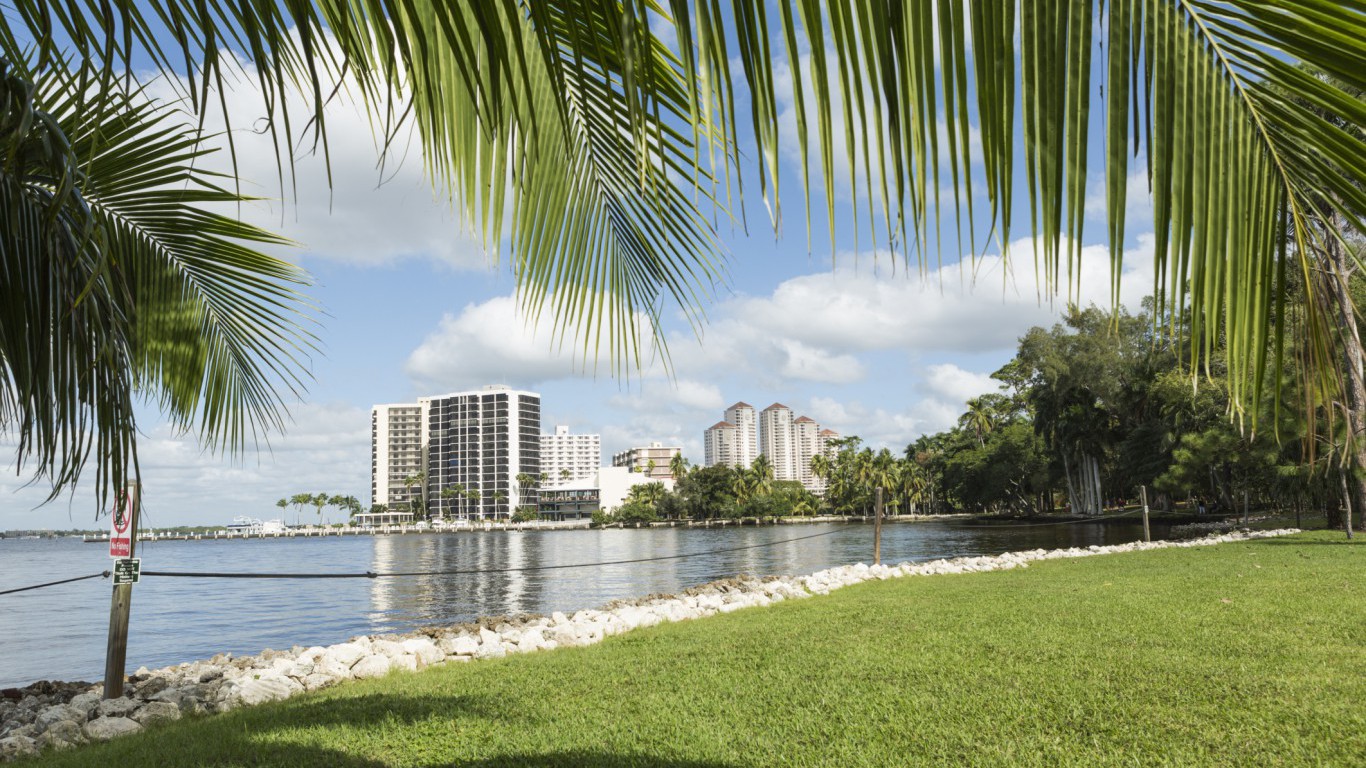Special Report
America's Largest Cities With No Public Transportation

Published:
Last Updated:

Americans overwhelmingly support mass transit, according to polls, surveys, and support at the ballot box. There were 62 transportation measures on ballots across the United States in 2012, according to the Center for Transportation Excellence, and nearly 80% of them passed. Yet while a strong majority of voters support mass transit, very few people actually use it. Only 5% of Americans actually commute using mass transit, according to U.S. Census data. Suburban sprawl has worked against achieving the population density needed to make mass transit viable.
Americans may say they support public transportation, but their commuting habits suggest it is difficult to get them out of their cars. More than 76% of workers drive to work alone, according to Census data. Just 8.9% of commuters carpool, 2.7% walk to work, and 0.5% ride a bicycle to their place of employment.
American transportation infrastructure does not encourage use of mass transit even when it is available. Commuters balk at taking buses because of route restrictions and because they do not want to make transfers. Trains are more accessible in the Northeast and in some parts of the Midwest, but in other parts of the nation, catching a train requires driving to a station.
24/7 Wall St. found that in five U.S. cities with a population of 100,000 people or more, there is virtually no public transportation. Two of those five cities are in Florida, and the others are in the Plains states and Texas.
At the other end of the mass-transit use spectrum, there are only 14 cities where 20% or more of the commuting population uses public transportation, and eight are in the Northeast. New York is first, with 55.8% of commuters taking public transportation. That percentage would probably be even higher if the city’s massive subway system connected to Staten Island. Jersey City, just across the Hudson River from New York, is second with 51.4%.
More than 20% of commuters in four California cities — San Francisco, Oakland, Berkeley, and Daly City — use public transportation. In Los Angeles, 8.9% of commuters use public transportation.
Methodology
To determine the cities that have no public transportation, 24/7 Wall St. reviewed the percentage of the civilian employed population 16 years and older commuting to work by public transportation (excluding taxicab) from the U.S Census Bureau’s American Community Survey 2017 one-year estimates. Cities with percentages at 0% or close to 0% were investigated further to determine whether there were no reasonable options for public transportation. Only incorporated cities with a population greater than 100,000 were considered. Median household income, poverty rate, and educational attainment rate also came from the 2017 ACS.
Click here to see America’s largest cities without public transportation.

5. Broken Arrow, Oklahoma
> Population: 110,468
> People who drive to work: 94.4%
> People who drive to work alone: 86.2%
More than 94% of Broken Arrow commuters use a car, truck, or van to go to work, according to Census data, and 86.2% of them drive alone. Broken Arrow had operated its own bus service, but in 2005, the city handed over operations to Tulsa’s transit service. There is no train service in Broken Arrow. The nearest train station is in Tulsa Union Depot, about 14 miles away.
The public school system is the largest employer in Broken Arrow, and the biggest private employers are Walmart and flight navigation systems manufacturer FlightSafety.
Broken Arrow is about 14 miles southeast of Tulsa, and as its name would suggest, the city has a Native American legacy. Broken Arrow is name of the place where many of the Muscogee Creek Native American people had lived when they were still in Alabama, before they were forced to move west by the U.S. government on the Trail of Tears.
[in-text-ad]

4. Olathe, Kansas
> Population: 137,500
> People who drive to work: 92.1%
> People who drive to work alone: 84.5%
Olathe, Kansas, is about 22 miles southwest of Kansas City, Missouri, and is the fourth-largest city in Kansas. Kansas City is also the location of the nearest train station to Olathe.
Technology company Garmin International and Farmers Insurance are among the biggest employers in the region. The city’s current unemployment rate is 2.5%, far below the national rate.
Olathe has a well-educated workforce, and a relatively large share of workers work from home, which may partially reduce the need for public transportation. Nearly half of Olathe’s adults hold a bachelor’s degree, far more than the 32.0% national college attainment rate, and 6.8% of Olathe’s workforce works from home, above the national average of 5.2%.

3. Port. St. Lucie, Florida
> Population: 189,331
> People who drive to work: 92.5%
> People who drive to work alone: 80.6%
Port St. Lucie is the eighth largest city in Florida, with a population of more than 189,000. The city’s population has increased by 15.3% since 2010. Port St. Lucie has one of the higher homeownership rates in the nation, at 76.3%, more than 12 percentage points above the national rate.
The city’s current public transportation infrastructure, however, may be insufficient for its rapidly growing population. The two bus services that operate in Port St. Lucie are mostly used for senior citizens. The nearest train stations to Port St. Lucie are the one in Mangonia Park in West Palm Beach and the Okeechobee Amtrak station, both more than 40 miles away.

2. Cape Coral, Florida
> Population: 183,356
> People who drive to work: 92.7%
> People who drive to work alone: 83.5%
Cape Coral is one of the fastest growing cities in the nation, soaring to a population of more than 183,000 in 2017 from just 280 in 1960. But the city is lacking in public transportation for commuters.
Before it was developed by the Rosen brothers, Jack and Leonard, in the late 1950s, the area was called Redfish Point. It is located across the Caloosahatchee River, about nine miles southwest of Fort Myers. The Rosens renamed the place Cape Coral and embarked on a massive dredging project that created a honeycomb of canals and raised the land elevation to the level required to build homes.
Cape Coral would eventually have about 400 miles of canals, more than Venice, Italy. It is perhaps understandable why this city carved out of Florida’s swampy wilderness would not have public transportation options for commuters.
The area also is vulnerable to storm surge from hurricanes, and was severely impacted by devastating storms such as Hurricane Donna in 1960 and Hurricane Irma in 2017.
[in-text-ad-2]

1. Arlington, Texas
> Population: 396,407
> People who drive to work: 93.6%
> People who drive to work alone: 82.0%
Arlington, Texas, is the largest city in the United States without a mass transportation system. The city has attempted pilot projects of limited bus service in the past that included lines to Fort Worth and Dallas, and connections to Dulles-Fort Worth Airport.
The lack of mass transportation may inhibit the city of nearly 400,000 people from leveraging its assets, which include the Dallas Cowboys football stadium, the Arlington campus of the University of Texas, and a burgeoning entertainment district. Arlington’s public transportation options increased slightly in December 2017, when the ride-sharing program Via began operating in the city. However, the city still does not have a public bus service. Arlington has expressed interest in being a stop on the proposed Dallas-Fort Worth rail line.
Thank you for reading! Have some feedback for us?
Contact the 24/7 Wall St. editorial team.